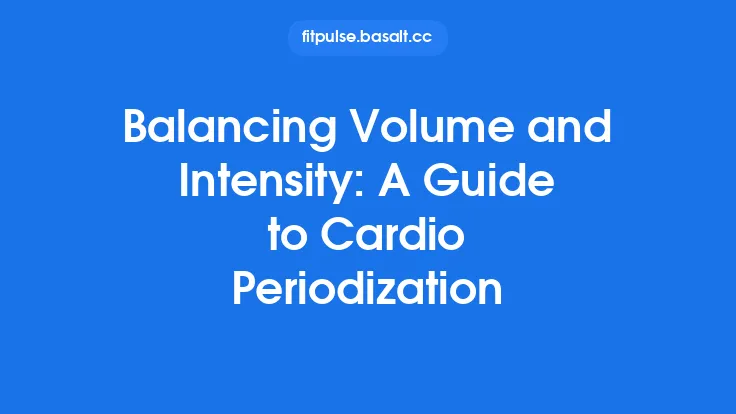Aerobic endurance is the cornerstone of any fitness journey that aims to improve overall stamina, cardiovascular health, and the ability to sustain activity over extended periods. For beginners, the concept can feel abstract—how does one “build” endurance, and what does it actually mean to have a strong aerobic base? This guide breaks down the essential ideas behind aerobic endurance, explains the energy systems that keep you moving, and offers practical steps to start developing lasting stamina without diving into the more advanced topics covered in other specialized articles.
Defining Aerobic Endurance
At its simplest, aerobic endurance refers to the capacity of your heart, lungs, and circulatory system to deliver oxygen to working muscles during prolonged, moderate‑intensity activity. When you can keep a jog, bike ride, swim, or brisk walk going for 30 minutes, an hour, or longer without feeling exhausted, you are demonstrating aerobic endurance.
Key characteristics of aerobic endurance include:
- Sustained effort: Activities last from several minutes to many hours.
- Oxygen reliance: The body primarily uses oxygen to convert stored fuels (carbohydrates and fats) into usable energy.
- Steady‑state rhythm: Heart rate, breathing, and perceived effort settle into a relatively stable range after the initial warm‑up period.
Unlike short, explosive bursts that rely on anaerobic pathways, aerobic endurance is about maintaining a rhythm that your body can support for a long time.
Core Energy Pathways in Aerobic Activity
While a deep dive into cellular metabolism belongs elsewhere, it helps to know that aerobic endurance draws on two main fuel sources:
- Carbohydrate oxidation (glycogen/glucose): Provides quick, efficient energy, especially at higher intensities within the aerobic zone.
- Fat oxidation: Becomes the dominant source as intensity drops and duration lengthens, allowing the body to tap into abundant energy reserves.
During a typical aerobic session, both fuels are used simultaneously, with the proportion shifting based on how hard you’re working and how long you continue. Understanding that your body can switch between these fuels explains why you can keep moving for extended periods without “running out” of energy.
Common Forms of Aerobic Exercise
Aerobic endurance can be cultivated through a wide variety of activities. The best choice is one you enjoy enough to repeat regularly. Here are some of the most accessible options:
| Activity | Typical Intensity (% of max HR) | Typical Session Length |
|---|---|---|
| Brisk walking | 50‑65% | 30‑60 min |
| Jogging / running | 65‑80% | 20‑45 min |
| Cycling (road or stationary) | 60‑80% | 30‑90 min |
| Swimming (continuous laps) | 60‑75% | 20‑60 min |
| Rowing (steady pace) | 65‑80% | 20‑45 min |
| Low‑impact aerobics classes | 55‑70% | 30‑60 min |
Each of these activities engages large muscle groups in a rhythmic pattern, encouraging the cardiovascular system to adapt and improve.
Building a Beginner’s Aerobic Routine
Starting a new endurance program doesn’t require fancy equipment or a gym membership. Follow these straightforward steps to lay a solid foundation:
- Set a realistic frequency – Aim for 3–4 sessions per week. Consistency beats occasional marathon‑like efforts.
- Begin with manageable duration – Start with 15‑20 minutes of continuous activity at a comfortable pace. If you’re new to exercise, even a brisk 10‑minute walk counts.
- Gradually extend time – Add 5 minutes to each session every week or two, depending on how you feel. This “time‑progression” approach builds endurance without overwhelming the body.
- Maintain a conversational pace – You should be able to speak in full sentences without gasping. This is a practical indicator that you’re staying within the aerobic zone.
- Include a brief warm‑up and cool‑down – 5 minutes of easy movement before and after each session helps transition your heart rate smoothly.
- Track your sessions – A simple notebook or phone app can record date, activity, duration, and perceived effort. Seeing progress on paper is motivating.
Understanding Training Intensity and Duration
Two variables drive aerobic improvements: intensity (how hard you work) and duration (how long you work). For beginners, the emphasis should be on duration while keeping intensity moderate.
- Low‑moderate intensity (50‑65% of max heart rate): Ideal for building a base. You can sustain this for longer periods, which gradually expands your aerobic window.
- Moderate intensity (65‑75% of max heart rate): Introduces a slightly higher demand, encouraging the heart and lungs to become more efficient.
- High‑moderate intensity (75‑85% of max heart rate): Useful once a base is established; it pushes the system a bit harder without entering the anaerobic realm.
A practical way to gauge intensity without a heart‑rate monitor is the “talk test.” If you can sing a simple song, you’re likely in the low‑moderate zone. If you can hold a conversation but feel a mild increase in breathing, you’re in the moderate zone. If speaking becomes challenging but you can still manage short phrases, you’re approaching the high‑moderate zone.
Tracking Progress Without Advanced Tools
You don’t need a lab or sophisticated wearables to see improvement. Here are low‑tech methods that work well for beginners:
| Method | What It Shows | How to Use |
|---|---|---|
| Distance logs (e.g., miles walked, kilometers cycled) | Increases in how far you can go in a set time | Record the distance after each session; aim for a modest weekly increase |
| Time‑to‑complete a set route | Faster completion indicates better stamina | Choose a familiar loop (e.g., a 5‑km park trail) and note the time it takes |
| Perceived Exertion Scale (1‑10) | Subjective feeling of effort | Rate each session; a lower number for the same duration signals progress |
| Heart‑rate recovery (pulse count after stopping) | How quickly your heart returns to resting rate | Count beats for 15 seconds immediately after stopping; a faster drop is a good sign |
These simple metrics provide tangible evidence that your aerobic capacity is improving, reinforcing motivation.
Lifestyle Factors that Support Aerobic Stamina
While the focus here is on the exercise component, a few everyday habits can subtly boost your endurance journey:
- Adequate sleep: 7‑9 hours per night supports cardiovascular recovery and hormone balance.
- Hydration: Even mild dehydration can raise perceived effort and limit performance.
- Stress management: Chronic stress elevates resting heart rate, making aerobic work feel harder.
- Consistent daily movement: Short walks, taking stairs, or light chores keep the circulatory system active on non‑training days.
Incorporating these habits doesn’t require a major lifestyle overhaul; small, consistent choices compound over weeks and months.
Frequently Asked Questions
Q: How long does it take to notice improvements in stamina?
A: Most beginners report a perceptible increase in endurance after 3‑4 weeks of regular training, especially when session duration is gradually extended.
Q: Can I improve aerobic endurance without raising my heart rate much?
A: Yes. By focusing on longer, low‑intensity sessions (e.g., walking or easy cycling), you still stimulate the aerobic system and build a solid base.
Q: Should I mix different aerobic activities?
A: Variety can keep training enjoyable, but for the first few months, sticking to one primary activity helps you track progress more clearly. Once comfortable, adding another mode can prevent boredom.
Q: Is it okay to skip a session if I feel tired?
A: Listening to your body is important. If fatigue is mild, a shorter or lower‑intensity session can be a good compromise. Persistent exhaustion may signal the need for an extra rest day.
Q: How do I know when to increase intensity?
A: When you can comfortably complete your current duration without noticeable effort (e.g., the talk test shows you could speak easily), it’s a cue to either add a few minutes or raise the pace slightly.
Bringing It All Together
Aerobic endurance is fundamentally about the ability to keep moving, powered by oxygen, for extended periods. By understanding the basic energy pathways, selecting enjoyable activities, and following a simple, progressive routine, beginners can lay a durable foundation for stamina. Tracking progress with straightforward tools, supporting the training with healthy daily habits, and staying attuned to how the body feels will ensure steady improvement without the need for complex equipment or advanced scientific knowledge.
Start with a modest goal—perhaps a 20‑minute walk three times a week—and watch as each session builds upon the last. Over weeks and months, that modest habit will transform into a reliable source of energy, confidence, and overall well‑being, proving that aerobic endurance is as much a lifestyle choice as it is a fitness metric.




